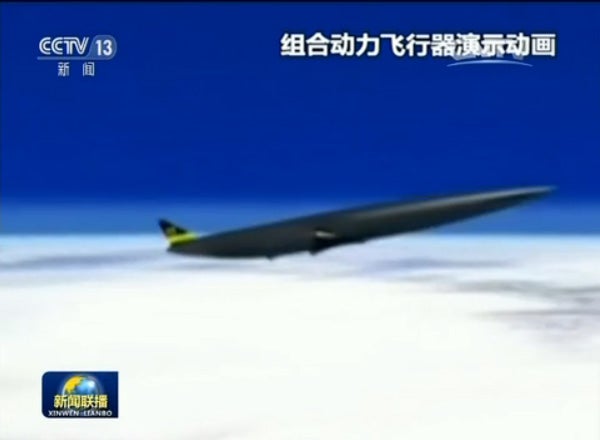China’s Hybrid Spaceplane Could Reset The 21st Century Space Race
It takes off from a runway, flies at hypersonic speeds, then rockets into orbit

While SpaceX is making news with its recoverable rockets, China announced that it is working on the next big thing in spaceflight: a hypersonic spaceplane.
The China Aerospace Science and Technology Corporation is beginning advanced research on a high tech, more efficient successor to the retired Space Shuttle, with hybrid combined cycle engines that can takeoff from an airport’s landing strip and fly straight into orbit. The hybrid space plane’s combined cycle engines would use turbofan or turbojet engines to takeoff horizontally from a landing strip. Once airborne, the engine then shifts to ramjet propulsion and, as speed increases, adjusts into a scramjet engine with supersonic airflow. At the scramjet stage, the hybrid spaceplane would enter hypersonic flight in ‘near space’, the part of the atmosphere between 20km to 100km above sea level. Finally, the hybrid spaceplane would use its rocket motors to push out of near space and into orbit.
Broadcasts by both state television broadcaster CCTV, and its English service, note that the CASTC spaceplane’s easy reusability would exponentially bring down space launch costs.

Combined Cycle Engine

Skylon

Hybrid Propulsion
Zhang Yong, a CASTC engineer, claimed that China will master the spaceplane’s technologies in the next three to five years, and a full-scale spaceplane would then enter service by 2030.
Interestingly, another CASTC engineer, Yang Yang, mentioned that the spaceplane would improve “ease of access to space for untrained persons,” as the space plane would have more gradual acceleration than a space launch rocket (reducing the physical strain on astronauts during takeoff), suggesting a version of the spaceplane which could be used for space tourism.

Feng Ru

The Missing Drone
Getting the complex technologies, like the combined cycle ramjet/turbo engine, in the reported timeline is an extremely ambitious target. Yet China is actually a world leader in a number of the key technologies for the project. In 2015, Professor Wang Zhengou was awarded the Feng Ru prize (China’s top aeronautical medal) for his work in successfully developing and flying a scramjet engine, making China the second nation in the world after the United States to master scramjet technology. CASTC’s rapid research timeline also suggests that the reports in 2015 of a Mach 4 test flight for a recoverable drone testbed for a combined cycle ramjet/turbofan engine were accurate. And China also has the world’s largest hypersonic wind tunnel, the Mach 9 JF-12, which could be used to easily test hypersonic scramjets without costly and potentially dangerous flight testing at altitude.
China already has a variety of advanced solid-and liquid-fuelled space rockets and even China’s historical weakness in turbine engines may not be a problem (the proven WS-10 turbofan is likely to provide enough thrust for the combined cycle engine’s ramjet to take over). For CASTC, the biggest challenge may be in integrating all these components into a single propulsion package, as well as building an airframe light and strong enough to resist the rigors of hypersonic flight and atmospheric reentry

The Future of the PLAAF, 2030?
Whether the project meets with success within the targeted timeframe or it slips by several years, the results would be significant, and not just on the civilian side of any space race. In addition to increasing the rate of access and lowered costs for space launches, the Chinese military could draw direct military benefits from the combined cycle engine technology. Without the rocket motor component, the combined cycle engine would be a good fit to power hypersonic UAVs and manned aircraft. Flying in near space at speeds above Mach 5, such aircraft could have global reach, while their speed and high altitude would make them effectively immune to all existing air defense systems (though the turbine part of the engine would need to emphasis fuel efficiency and high thrust to weight).

Shadow Dragon Hypersonic Bomber
Coming on the heels of other Chinese space advances, including the successful tests of a 3 meter diameter solid rocket booster, and the fuel turbopump for the LM-9 superheavy rocket, the present attention given to such a longterm project is notable. The high profile broadcast of Chinese breakthroughs in space technologies suggests that, in addition to boosting Chinese prestige, the Chinese leadership is looking to raise public awareness and support to justify costly investments in next generation space technology like hybrid spaceplanes and super heavy “Moon” rockets. Getting the first mover advantage in these aerospace milestones would definitely give China superpower status in both Earth and space.
You may also be interested in:
Chinese Hypersonic Engine Wins Award, Reshapes Space Race?
China Aims for Humanity’s Return to the Moon in the 2030s
China’s Largest Ever Space Rocket Takes Another Big Step Forward
China Showcases Plan to Become the Leading Space Power
China’s Space Station Plans in Powerpoint: A Closer Look at Tiangong 3